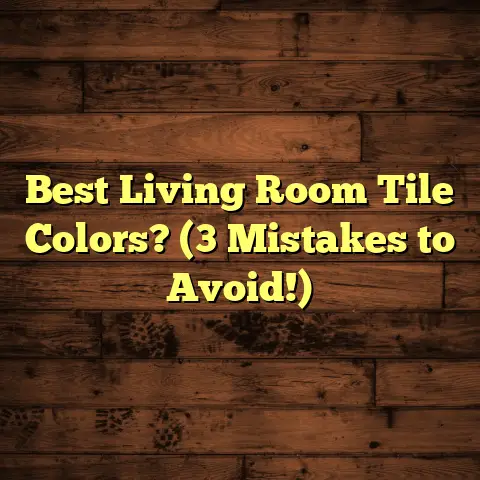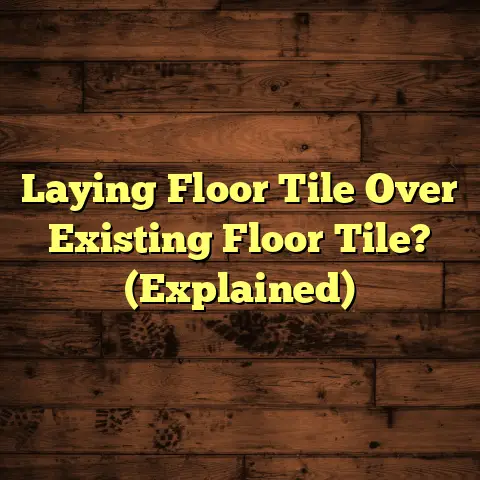Modern Laminate Edging: Top Choices? (Hot Trend!)
Have you ever walked into a room and just felt how put-together it was? Like, everything just flowed?
Chances are, it wasn’t just the furniture or the paint color. It was the finishing touches.
And when it comes to flooring, laminate edging is one of those details that can make or break a space.
I’m talking about that trim that seamlessly blends your laminate floor with the walls, doorways,
or even different types of flooring. It’s not just about looks, though. It’s about protecting your floor
and preventing those annoying tripping hazards. As a flooring contractor with years of experience,
I’ve seen firsthand how the right edging can completely transform a room. So, let’s dive into the world of
modern laminate edging, explore the hottest trends, and uncover the top choices that’ll elevate
your next flooring project!
Understanding Laminate Flooring
Okay, first things first. Let’s make sure we’re all on the same page about what laminate flooring actually is.
Laminate is a multi-layer synthetic flooring product fused together with a lamination process. It typically
simulates wood (or sometimes stone) with a photographic applique layer under a clear protective layer.
Think of it as a high-resolution photograph of wood glued onto a sturdy core board.
This core is usually made of high-density fiberboard (HDF) or medium-density fiberboard (MDF).
The wear layer on top protects the image from scratches, fading, and general wear and tear.
Laminate flooring has exploded in popularity over the past few decades, and for good reason. It’s generally
more affordable than hardwood, easier to install (hello, DIY!), and surprisingly durable.
Plus, the advancements in printing technology mean you can get laminate that looks incredibly realistic.
But here’s the thing: even the most beautiful laminate floor needs the right edging to truly shine.
That’s where our focus comes in!
What is Laminate Edging, Anyway?
So, what exactly is laminate edging? Simply put, it’s the trim that covers the edges of your laminate floor.
It bridges the gap between the flooring and the surrounding surfaces, like walls, doorways, or other floors.
Think of it as the frame around a painting – it defines the boundaries and completes the overall look.
There are several different types of laminate edging, each with its own specific purpose and aesthetic:
-
T-Molding: This is used to join two laminate floors of the same height together, typically
in doorways or between rooms. It has a “T” shape, with the top of the “T” covering the gap.
-
Reducer Strips: These are designed to transition between laminate flooring and floors of
different heights, such as tile or carpet. They create a smooth, gradual slope to prevent tripping.
-
Quarter Rounds: These are small, rounded moldings that are typically used to cover the gap
between the laminate floor and the baseboards. They provide a clean, finished look.
-
Thresholds: These are used at doorways to cover the transition between two different types of
flooring. They can be made of various materials, including laminate, metal, or wood.
Beyond just aesthetics, edging also plays a crucial role in protecting your floor. It prevents moisture
from seeping under the edges, which can cause warping and damage. It also helps to prevent the edges
of the laminate from chipping or peeling, especially in high-traffic areas.
Current Trends in Laminate Edging
Alright, now let’s get to the fun stuff – the latest trends in laminate edging! Just like fashion, flooring
trends are constantly evolving. Here’s what’s hot right now:
-
Color-Matched Trims: Gone are the days of settling for a generic brown or beige trim. The trend
now is to perfectly match the edging to the color and finish of your laminate floor. This
creates a seamless, cohesive look. Many manufacturers now offer matching trim options for their
laminate flooring lines, making it easier than ever to achieve this look.
-
Beveled Edges: Instead of a sharp, abrupt transition, beveled edges offer a softer, more
gradual slope. This is especially popular for reducer strips, as it creates a smoother transition
between different floor heights.
-
Textured Finishes: Adding texture to laminate edging is another way to elevate the look. This
could be anything from a subtle wood grain texture to a more pronounced hand-scraped effect.
-
Eco-Friendly Materials: As sustainability becomes increasingly important, more and more homeowners
are opting for eco-friendly laminate edging options. This could include trim made from
recycled materials or sustainably sourced wood.
-
Minimalist Designs: Clean lines and simple profiles are also trending in laminate edging.
Think sleek, low-profile trims that blend seamlessly with the surrounding surfaces.
Top Choices for Modern Laminate Edging
Okay, let’s get down to brass tacks. Here are my top choices for modern laminate edging, based on my experience
as a flooring contractor. I’ll break down the pros and cons of each, so you can make the best choice
for your specific needs.
1. T-Molding: The Versatile Workhorse
T-molding is a classic for a reason. It’s incredibly versatile and can be used in a variety of applications.
As I mentioned before, it’s primarily used to join two laminate floors of the same height together.
This is common in doorways, between rooms, or in large open spaces where you want to break up the flooring.
Pros:
- Versatile: Can be used in many different situations.
-
Durable: Typically made from sturdy materials that can withstand
high traffic. * Easy to Install: Most T-moldings simply snap into place or are secured with adhesive.
Cons:
-
Can be visually clunky: The “T” shape can sometimes be a bit too noticeable, especially
in minimalist designs. * Not ideal for transitioning to different floor heights: This is where reducer strips come in.
2. Reducer Strips: Bridging the Gap
Reducer strips are your go-to solution for transitioning between laminate flooring and floors of
different heights. They create a smooth, gradual slope that prevents tripping and looks much more polished
than a simple, abrupt transition.
Pros:
- Safe and Functional: Prevents tripping hazards.
- Visually Appealing: Creates a smooth, professional transition.
-
Available in various materials and finishes: You can find reducer
strips that match your laminate floor perfectly.
Cons:
- Can be tricky to install: Requires precise measurements and careful cutting.
-
May not be suitable for very large height differences: In extreme cases, you may need
a custom solution.
3. Quarter Rounds: The Finishing Touch
Quarter rounds are the unsung heroes of laminate edging. They may seem small and insignificant, but they
play a crucial role in providing a finished look around baseboards.
They cover the gap between the laminate floor and the wall, concealing any imperfections and
preventing dust and debris from collecting in the gap.
Pros:
- Inexpensive: Quarter rounds are one of the most affordable edging options.
- Easy to Install: Can be easily nailed or glued into place.
- Adds a Polished Look: Provides a clean, finished appearance.
Cons:
-
Can be easily damaged: Being small and thin, quarter rounds are susceptible to dents and
scratches. * May not be suitable for all design styles: Can look too traditional in very modern spaces.
4. Thresholds: Defining Doorways
Thresholds are specifically designed for doorways. They cover the transition between two different
types of flooring, providing a clean and visually appealing separation between rooms.
Pros:
-
Durable: Thresholds are typically made from sturdy materials like metal or solid
wood, which can withstand heavy foot traffic. * Visually Appealing: Creates a defined transition between rooms. * Can be used with different flooring types: Suitable for
transitions between laminate, tile, carpet, and more.
Cons:
- Can be expensive: High-quality thresholds can be pricey.
-
Installation can be tricky: Requires precise measurements and careful installation to ensure
a flush fit.
5. Custom Edging Options: Personalize Your Space
In recent years, there’s been a growing trend towards custom laminate edging. Homeowners are
looking for ways to personalize their spaces and create a truly unique look.
This could involve using unconventional materials, creating custom profiles, or even incorporating lighting into
the edging. I’ve seen some incredible examples of this, from metal edging with embedded LED lights to custom-
shaped wood trim that perfectly complements the architectural details of the room.
Pros:
- Unique and Personalized: Allows you to create a truly one-of- a-kind look.
- Can perfectly match your design vision: No need to settle for generic options.
Cons:
- Expensive: Custom edging can be significantly more expensive than standard options.
-
Requires specialized skills: You’ll likely need to hire a skilled carpenter or craftsman
to create and install custom edging.
Installation and Maintenance
Okay, so you’ve chosen your perfect laminate edging. Now what? It’s time to install it!
While the specific installation process will vary depending on the type of edging you’ve chosen,
here are some general tips to keep in mind:
-
Measure Carefully: Accurate measurements are crucial for a professional-looking result.
Measure twice, cut once! * Use the Right Tools: Make sure you have the appropriate tools for the job, such as a miter saw,
a nail gun, or a tube of construction adhesive. * Follow the Manufacturer’s Instructions: Always read and
follow the manufacturer’s instructions carefully. * Take Your Time: Don’t rush the installation process. Take your time and pay attention
to detail.
Once your laminate edging is installed, it’s important to maintain it properly to keep it
looking its best. Here are some maintenance tips:
-
Regular Cleaning: Wipe down your laminate edging regularly with a damp cloth to remove dust
and dirt. * Avoid Harsh Chemicals: Don’t use harsh chemicals or abrasive cleaners, as these can damage
the finish. * Protect from Moisture: Avoid excessive moisture, as this can cause warping and damage. * Repair Damage Promptly: If you notice any damage, such as
chips or dents, repair it promptly to prevent further damage.
Choosing the Right Edging for Your Space
So, how do you choose the right laminate edging for your specific space? Here are some factors to consider:
-
Room Style: The style of your room should influence your edging choice. For example,
a minimalist room might call for sleek, low-profile trim, while a more traditional room might benefit
from ornate quarter rounds. * Flooring Color: As I mentioned earlier, color-matched trims are a hot trend right now. But even
if you don’t go for a perfect match, make sure the edging complements the color of your
laminate floor. * Overall Design Theme: Consider the overall design theme of your home. The edging should tie in
with the other design elements in the room, such as the furniture, the paint color, and the accessories.
-
Transition Needs: What kind of transitions do you need to make? Are you transitioning between
laminate and carpet? Laminate and tile? Different heights? Choose the edging that best
suits your transition needs.
Case Studies and Real-Life Applications
Let’s take a look at some real-life examples of how modern laminate edging can transform a space.
Case Study 1: The Modern Farmhouse
In this modern farmhouse kitchen, the homeowners opted for color- matched laminate edging with a
subtle wood grain texture. This creates a seamless transition between the laminate floor and
the white shiplap walls. The clean lines and simple profile of the edging perfectly complement
the minimalist design of the kitchen.
Case Study 2: The Contemporary Living Room
In this contemporary living room, the homeowners chose sleek, low-profile metal edging.
This provides a modern and sophisticated look. The metal edging also complements the other
metal accents in the room, such as the light fixtures and the furniture legs.
**(Unfortunately, I can’t provide actual before-and-after images here, but hopefully these descriptions
give you a good idea of the impact that the right laminate edging can have.)**
Conclusion
So, there you have it – a deep dive into the world of modern laminate edging! As you can see, it’s not
just a minor detail. It’s an essential element that can significantly impact the overall
look and feel of your space. By choosing the right edging, you can create a seamless,
polished, and professional- looking result.
So, the next time you’re planning a flooring project, don’t overlook the importance of laminate edging.
Consider these top choices, think about your specific needs and design aesthetic, and choose
the edging that will truly elevate your space. You won’t regret it! Good luck, and happy flooring!





